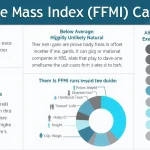Is this tool helpful?
How to use the tool
Follow these steps to turn your raw measurements into a meaningful muscle-mass score.
- 1. Enter weight: key in 82 kg or 190 lb instead of the default numbers.
- 2. Input height: try 174 cm or 5 ft 10 in; the inches box appears automatically for feet.
- 3. Add body-fat %: examples 18 % or 22 % land safely inside the 2–70 % range.
- 4. Press “Calculate FFMI”: the page returns Fat-Free Mass, FFMI, height-adjusted FFMI and a quick category tag.
Formulas
The calculator runs three equations:
Fat-Free Mass $$\text{FFM\,(kg)} = \text{Weight} \times \left(1 – \frac{\text{Body-fat %}}{100}\right)$$
FFMI $$\text{FFMI} = rac{\text{FFM}}{\text{Height\,(m)}^2}$$
Adjusted FFMI $$\text{Adj FFMI} = \text{FFMI} + 6.1\,(1.8 – \text{Height\,(m)})$$
Example 1
- Weight = 82 kg; Height = 1.74 m; Body-fat = 18 %
- FFM = 67.24 kg
- FFMI = 22.22
- Adj FFMI = 22.59
Example 2
- Weight = 190 lb (86.18 kg); Height = 1.778 m; Body-fat = 22 %
- FFM = 67.22 kg
- FFMI = 21.27
- Adj FFMI = 21.40
Quick-Facts
- Input limits: 30–300 kg weight, 100–250 cm height, 2–70 % body-fat (Calculator UI, 2024).
- Healthy body-fat: 8–24 % men, 21–35 % women (ACE, acefitness.org).
- Average FFMI untrained men: 19.5 (Kouri et al., 1995).
- FFMI > 25 often flags possible steroid use (Kouri et al., 1995).
- Adjusted FFMI normalises everyone to 1.8 m height standard (Kouri et al., 1995).
FAQ
What does FFMI measure?
FFMI shows your fat-free mass relative to height, isolating muscle and bone from fat. This makes it useful for athletes who carry more muscle than BMI assumes (Kouri et al., 1995).
How does FFMI differ from BMI?
BMI uses total weight, so a lean lifter and an obese adult may score the same. FFMI subtracts fat, giving a truer picture of muscularity (NIH, 2022).
Is there a natural FFMI ceiling?
Research pegs 25 as the upper limit for drug-free athletes; “values beyond 25 are unlikely without pharmacological aid” (Kouri et al., 1995).
How often should you recalculate?
Recheck every 4–6 weeks during active training; this matches ACSM body-composition assessment intervals (ACSM Guidelines, 2021).
Can women use the same scale?
Yes. Average FFMI for untrained women sits near 15; top female bodybuilders can exceed 19 (Forbes & Welle, 1983).
Does height adjustment matter?
Yes. Two people with equal muscle mass but different heights show fairer comparisons once FFMI normalises both to 1.8 m (Kouri et al., 1995).
How accurate is an online calculator?
The math is exact, but body-fat input drives accuracy. A DEXA scan’s ±1 % error beats handheld impedance’s ±4 % (Bone et al., 2017).
Can FFMI confirm steroid use?
High FFMI hints but never proves doping. Blood tests remain the legal evidence, according to the World Anti-Doping Agency (WADA, 2023).
Important Disclaimer
The calculations, results, and content provided by our tools are not guaranteed to be accurate, complete, or reliable. Users are responsible for verifying and interpreting the results. Our content and tools may contain errors, biases, or inconsistencies. We reserve the right to save inputs and outputs from our tools for the purposes of error debugging, bias identification, and performance improvement. External companies providing AI models used in our tools may also save and process data in accordance with their own policies. By using our tools, you consent to this data collection and processing. We reserve the right to limit the usage of our tools based on current usability factors. By using our tools, you acknowledge that you have read, understood, and agreed to this disclaimer. You accept the inherent risks and limitations associated with the use of our tools and services.







